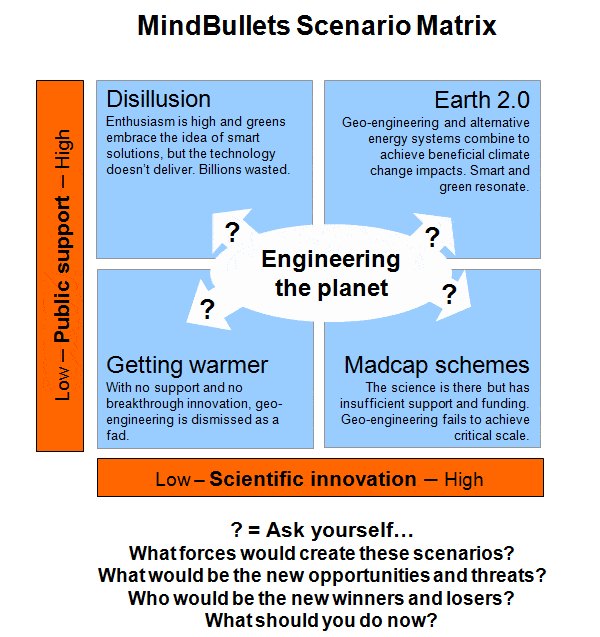
WELCOME TO EARTH 2.0

Geo-engineering creates a new environment for a smart planet
- Dateline
- 21 September 2027
Our planet couldn’t cope with all the demands our modern civilization placed on it. So we built a new one. Welcome to Earth 2.0. A new planet for a new, sustainable future.
Facing the 21st century’s greatest threat, we have risen to the challenge, and made our world more habitable for generations to come. But not by destroying natural structures and building artificial surroundings. The very opposite is true. Smart meets green in the New Earth philosophy.
Richard Branson started it all with his Virgin Earth Challenge. That was two decades ago. Take a look around now. The world seems positively retro.
Sure, cities are bigger, and more populous, but they look more like villages of old, with grassy areas and vegetable gardens on the roof. And what’s this new career? Growing back tropical jungles? Wow!
Admittedly, there are some strange-looking trees lining the highways. Designed to soak up carbon emissions and generate energy, they help to keep the planet cool. But the best part is: their nano-fibers are made of chicken feathers and organic plastic. Ok, they’ve got synthetic leaves, but isn’t that better than melting ice-caps?
It’s not all good news – we still generate huge amounts of waste, living our post-modern lives – but the invention of the glyco-fuelcell means it really pays to turn your garbage into electricity.
It wasn’t easy building another Earth, and not just because of skeptics and objectors. But huge challenges created enormous opportunities for business.
You might think that Earth 2.0 is just for humans, but you’d be wrong. It turns out – now that we’ve secured our own future – we value biodiversity above all else. Why? Because it’s in our own best interest in the long run.
Good karma is good for the whole planet, and for us too.
ANALYSIS >> SYNTHESIS: How this scenario came to be
“We are as gods and HAVE to get good at it.”
These are the first words of Whole Earth Discipline, Stewart Brand’s new book. In it he argues that we are so successful as a species, we have a responsibility to manage the planet to the best of our ability. Brand’s central thesis is that nuclear power is green, GM foods are green, cities are green and geo-engineering is worth considering. He argues that a smart approach to solving global environmental issues is a moral imperative.
The Earth Island Institute disagrees: “We may be technologically capable of hacking the sky, but politically and ethically unprepared to do so.” In a debate over the benefits and challenges of geo-engineering, the first conclusion seems to be that we need more research, and shouldn’t assume that planetary manipulation is either a magic bullet or totally flawed. Jason Mark, editor of Earth Island Journal, worries that if we take control of the weather, we lose our place in nature. He quotes Thomas Berry: “Our own well-being can be achieved only through the well-being of the entire world around us.”
Some of the top scientific minds in the US and UK are actively researching proposals for geo-engineering schemes specifically designed to counteract global warming. Many of these, which can be explored in the links below, are grandiose and rely on huge investments in technology; sometimes massive volumes of machinery.
But there is a micro approach to geo-engineering which has received little attention. With a world population of 6.5 going on 7 billion, we obviously have the capacity to impact the planet. Many would claim that our civilization has already damaged the planet beyond repair. If we could harness that capacity for activity and find innovative ways to make a positive impact – by billions of people – surely that would result in micro-engineering on a global scale?
2009: Geo-engineering proposals
Proposals for geo-engineering schemes to address climate change get serious attention. In the UK, Oxford Geoengineering is founded to research all the implications of geo-engineering approaches. The British government’s chief scientist advises that geo-engineering schemes may be feasible. The Royal Society and the Institute of Mechanical Engineers both issue reports claiming feasibility for selected approaches.
In the US, White House science adviser John Holdren is giving geo-engineering credence. “We don’t have the luxury of taking any approach off the table,” he tells the Associated Press. Rather than advocating direct intervention immediately, Holdren qualifies his statement as a support for research into plausible schemes.
A prototype Carbon Scrubber machine for removing CO2 from the ambient atmosphere is tested in Michigan. It is only one of 900 ideas submitted to the Virgin Earth Challenge, launched by Richard Branson in 2007.
2011: Artificial trees
Cellphone towers have reserve standby power, largely unused. An ambitious project gets underway to retro-fit millions of cellphone towers as artificial trees designed to clean up the air by absorbing CO2.
2014: Glyco fuel cell
A bacterial fuel cell that consumes simple sugars found in organic waste is developed. Besides producing electricity, the fuel cell also disposes of garbage which would otherwise rot, releasing methane and CO2.
2017: Biochar boom
A back-yard inventor from India perfects the charcoal bio-reactor. A fairly simple device, once running it converts agricultural waste from sources like sugarcane and jatropha into ‘clean’ charcoal, with minimal energy requirements. Biochar is mixed with organic fertilizers and returned to the soil, promoting growth of the next crop and trapping the carbon.
Charcoal bio-reactors quickly establish themselves all over the developing world. Biochar is also cleaner than coal for combustion purposes, and renewable.
2022: Urban organic chic
Rooftop gardens and white painted office blocks. See-through solar windows. Cities are producing more food, less waste and consuming far less energy than ever thought possible. Cleaner air is the immediate benefit.
Healthier lifestyles and lower medical costs bring a greater appreciation for the green spaces in and around our cities. Could this be the start of a virtuous cycle?
2025: Branson’s Carbon Prize
The Virgin Earth Challenge is won by a team of scientists in Cambridge, England for the invention of the synthetic leaf. An ideal clone of nature, the ‘Leaph’ uses bio-mimicry to convert CO2 into methanol. The Leaph is in effect a miniature solar panel, and needs only sunlight to operate. “We are working on a double-sided Leaph,” says chief scientist Ranjeev Patel. “The underside will produce hydrogen fuel and release oxygen into the ambient atmosphere.”
Artificial trees blossom in all industrial areas as a result.
2028: Hello to Earth 2.0
The planet’s changing. It’s been subtly altered – in a good way. Although it will be decades before the tropical rainforests regain their former glory, and even longer before we see a climate change reversal, there is a new optimism in the air. Conflict over diminishing resources has eased, and people seem less concerned with future crises, and more at peace with the world. Has Gaia declared a truce?

Links to related stories
- Engineering Earth 'is feasible' - BBC News, 1 September 2009
- 'Artificial trees' to cut carbon - BBC News, 27 August 2009
- Post-human Earth: How the planet will recover from us - New Scientist, 30 September 2009
- How pollution might just save the planet - The Age, 11 October 2009
- Rethinking Green - Stewart Brand, 9 October 2009
- The Wide Angle: 5 Geoengineering Schemes - Discovery Tech online feature
- Better world: Top tech for a cleaner planet - New Scientist, 2 October 2009
- Geo-engineering does not offer an easy way out - Leonardo Energy, 13 October 2009
- MindBullet: 'PERFECT STORM' OF SHORTAGES AVERTED (Dateline: 1 September 2029, Published: 03 September 2009)
Warning: Hazardous thinking at work
Despite appearances to the contrary, Futureworld cannot and does not predict the future. Our Mindbullets scenarios are fictitious and designed purely to explore possible futures, challenge and stimulate strategic thinking. Use these at your own risk. Any reference to actual people, entities or events is entirely allegorical. Copyright Futureworld International Limited. Reproduction or distribution permitted only with recognition of Copyright and the inclusion of this disclaimer.